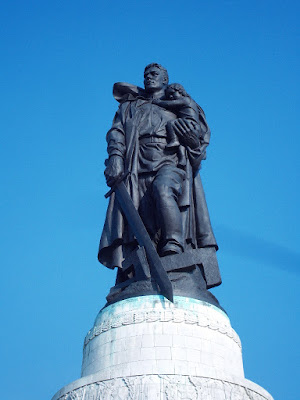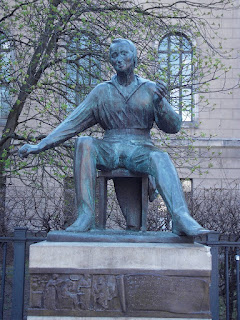I just love this, so I have to share. Only people who know German will understand, though:
Funny video where Turkish lyrics are interpreted as German
2011/04/25
2011/04/22
Soviet War Memorial (Ehrenmal) – Воин-освободитель
This impressive (12 m high) statue of a Soviet soldier holding a child (artist: Yevgeny Vuchetich/Евгений Викторович Вучетич) crushing the Hakenkreuz under his feet overlooks the burial site of 5,000 soldiers of the Red Army (among the 20,000) who fell in the Battle of Berlin in April/May 1945.
Built in Social Realist style in the Treptower Park, the vast memorial consist of a central area in front of the monument, lined on both sides by 16 stone block with decorated with military scenes and quotation from Joseph Stalin, both in Russian and German.
A portal consisting of a pair of stylized Soviet flags and flanked by two statues of kneeling soldiers builds the entrance to the central area.
Right opposite the gigantic statue on the other end of the center line, another figure, a female, represents the Motherland weeping at the loss of her sons.
Really artsy film about the site on Youtube by KrokyMovie
 |
| View from top of hill |
Right opposite the gigantic statue on the other end of the center line, another figure, a female, represents the Motherland weeping at the loss of her sons.
Really artsy film about the site on Youtube by KrokyMovie
 |
| Frescoes inside the gazebo beneath the statue |
2011/04/18
Treptower Park Impressions
 |
| Weeping Willow |
Why the hell has nobody ever told me about the Treptower Park? I don't get it. Do people wanna keep it to themselves, or what?
I only discovered this gorgeous beauty last weekend, in the course of a short film project, when we were supposed to shoot somewhere in Treptow-Köpenick.
Part of the super-sized park is a beautiful promenade alongside the river Spree. Feels like a holiday at one of the North Sea ports. For real! I like this part of the park most.
If you continue to follow the river, you come right to the "Insel der Jugend" (Isle of Youth), a tiny romantic, almost kitschy place. Wonderful.
If you prefer a stroll in the woods, the part between "Puschkinallee" and "Am Treptower Park" is more suitable for you. There you also find the gigantic Soviet War Memorial which is embedded in an artificial landscape.
 |
| View to the church on opposite peninsula Stralau |
 |
| Bridge crossing over to the Insel der Jugend (Isle of Youth) |
 |
| View to the bridge from the Insel der Jugend (Isle of Youth) |
 |
| Footprints of famous polar bear Knut (Eisbär Knut) |
 |
| Promenade alongside the River Spree |
 |
| Landscape between Puschkinallee and Am Treptower Park |
2011/04/05
Valet de Chambre builds Palais am Festungsgraben
 |
| Palais am Festungsgraben (former Palais Donner) |
The above Palais was originally built in baroque style by Johann Gottfried Donner, the Valet de Chambre of Prussian King Frederick II (Friedrich der Große) in 1753 and redesigned, one century later, with the – then very hip – classicistic "livery" it wears nowadays.
The Palais is situated right behind the chestnut grove of the New Guard House and is the only buiilding in this neighborhood that survived World War II relatively unscathed.
It disposes of several very representative halls and is used for festive receptions or exclusive events (can be chartered by you too!). It even won an award for being "one of the best event locations in Germany".
Furthermore, the building serves as a theater, hosts two galleries and the Tajik Tee Salon.
Old pictures of the building from the Federal Archive (Bundesarchiv)
Labels:
architecture,
Art,
culture,
East Side Gallery,
exhibition,
festival,
history,
houses,
location,
memorial,
World War II
2011/04/04
Two are better than One – Heinrich Heine Sculpture
This cheerful fella holds the fort, surrounded by the holy sites of the Humboldt University, the Gorki Theater, the New Guard House and the Palais am Festungsgraben.
 |
| Click pic to enlarge |
 |
| Click pic to enlarge |
The statue of the young Heinrich Heine (one of Germany's most significant poets), is, however, not as unique as you would think: The original statue was cast on the occasion of the 100th anniversary of Heine's death (in 1956) and designed to be mounted behind the New Guard House and in front of the Gorki Theater, but the GDR regime didn't care much for the "unheroic-ish" Bronze and its boyish charms and banned it to the Weinbergspark, somewhere in Wedding (one of Berlin's districts).
Just in time for the 200th birthday anniversary in 1997 (the GDR was dead then ...), discussions flared up, as to install the memorial where it was meant to be in the first place. Now, the Wedding people didn't like the idea and dug their claws deep into the statue to keep it in place.
Unceremoniously practical, an identical second statue was cast and mounted where you can see it now.
2011/04/03
A perfect Day
When I first came to Berlin, it didn't seem like such a big city to me. I have no idea why I thought it was smaller than Paris. In fact it is twice the size, and the more I know it, the bigger it gets.
There are so many "hidden places", so many treasures to discover, beautiful sites, beautiful squares and theaters and places, and if nothing else, beautiful people.
Today was one of the rare days in life that just seemed perfect.
Today was one of the rare days in life that just seemed perfect.
The Chinese say you should never praise the day until evening has come, and that is one of the hard and fast rules in life I stick to.
Okay, now, the evening has arrived and the past day held so many marvelous moments.
Starting out with a late night/early morning in a Kreuzberg bar with two delightful people and inspiring conversation, followed by a sweet and lazy sleep in, followed by a delicious breakfast, a stroll through Wedding's Brunnenstraße with a stop-by at the Trendmafia fashion market (taking place every first weekend in month and offering Berlin designed stuff), delicious ice cream from Bahnhof Friedrichstraße taken to the lively outdoor steps of the Grimm Center, and then ... the discovery of a wonderful, wonderful neighborhood: The surroundings of, and, the Palais am Festungsgraben.
This is a great place to hang out on a late Sunday afternoon.
Surrounded by this beautiful and yet so quiescent scenery. There are many gorgeous places in Berlin, but this one is really quiet!
2011/04/02
Berlin Wall Memorial
 |
| Berlin Wall Memorial Visitor Center |
From August 13, 1961 to November 9, 1989, a nasty line cut through Berlin's entire city center: The notorious Berlin Wall, built to prevent citizens of the GDR from fleeing to the West. West Berlin was an island located in the middle of the GDR.
As the wall alone couldn't stop people from trying to escape from the GDR regime, it was additionally fortified by a death strip all along the border, as well as a "shoot-to-kill" order.
The area along the restricted zone was patrolled, watchtowers were set up, signal fences giving silent alarms were installed and the land around the border was declared no-man's-land and was lit up bright as day during the night.
Observation platforms in the West allowed tourists and West Berliners to sneak a peek "over the fence" into an other world.
In the peaceful revolution of 1989, the guards of Bornholmer Straße border opened the gates on November 9th without formal order and masses of people flocked to the West.
The Berlin Wall Memorial partly is an open-air museum and the memorial grounds on the former border strip are open all year round. Admission is free. There also is a viewing platform at the Documentation Center (Bernauer Strasse 111). Don't miss it!
If you are up to some research, check out the specialized bookstore on the history of the Berlin Wall in the Visitor Center.
A really intriguing and actually quite spooky part of the Berlin Wall history is on display in the Nordbahnhof S-Bahn station: The "Ghost Station Exhibition".
What is this?
As a result of all the wall building and the busy cutting the city in two halves, public transport network had to be divided too. Three lines that passed through the city center and a short stretch of East Berlin territory stayed open to West Berliners while East Berlin stations were closed down.
Labels:
Berlin Wall,
books,
East Berlin,
excursion,
exhibition,
Gallery,
history,
library,
memorial,
museum,
promenade,
scurrility,
subway,
U-Bahn
2011/04/01
Villa von der Heydt – Classicist Survivor of Nazi Plans
When I got off the M29 at Köbisstraße to visit the Bauhaus Archive, I spotted a beautiful, beautiful classicist mansion right across the street. I only took two quick shots and googled the place later on, as I was curious about the mansion's history.
Turns out it is named "Villa von der Heydt" and it is one of the few remaining villas in "Tiergarten" (name of this area of the city) to survive Nazi urban planning, as well as World War II.
Not particularly well-versed in German history, I was, up to the present day, totally unaware of the Nazi plan to transform Berlin into a Welthauptstadt Germania (World Capital Germania).
According to the Nazi perception, Berlin's architecture was much too provincial – as compared to Paris' splendor, for example – to become the desired World Capital after a no-doubt-soon-to-be-gloriously-won World War II.
So, a word and a blow: Along the lines of Haussmann's redesign of Paris, Albert Speer, the designated architect, wanted to demolish no less than 52,000 homes in order to make room for the ginormous project.
The surviving "Villa von der Heydt" looks back on a, so it seems, quite turbulent history.
Nowadays the seat of the Stiftung Preußischer Kulturbesitz (Prussian Cultural Heritage Foundation), it was built in neo-renaissance style in 1862, by architect Hermann Ende, for Baron August von der Heydt.
After the Baron's sad demise in 1874, his heir rented the mansion out to a Chinese ambassador who – as word has it – used the location to run some kind of rather rambunctious tavern.
Oh, how I wish, I could travel back in time to take some wildly vicious shots of the sappy scenery ...
Afterwards the building was regained by one of the erector's grandnephews who transformed the site into one of Berlin's most brilliant salons.
After World War I the family sold the house to the "General German Sports Association" who, truth be told, didn't care much for work outs, but secretly established an illegal gambling den for its members.
In 1938 the house was bought by the Nazi regime and used as official residence for one of their ministers.
World War II put the beautiful house into ruins, leaving behind only the outer walls and the basement, where candy and chocolate was produced for a while, until the mansion was officially declared a landmark in the late 1960s, which finally led to its reconstruction in 1979.
Labels:
air raid,
architecture,
culture,
fairy tale,
fun,
houses,
scurrility,
World War I,
World War II
Subscribe to:
Posts (Atom)





































